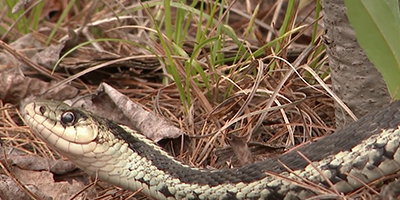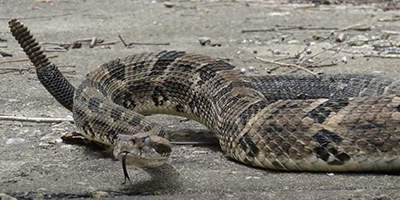
Welcome to hartfordsnakes.com! I am David, a snake enthusiast living in Hartford, CT. Many people don't know that Hartford is in fact full of snakes! You just need to know where to find them - they can often be shy and elusive. Some Connecticut snake species are more common outside of the city limits, in different parts of Hartford County CT, but many types of snakes are indeed common in the more urban parts of Hartford. This guide is meant to help educate you about the beautiful snakes of Hartford, and to help you identify the most common snakes of Hartford, as well as the venomous snakes of Hartford that you should learn to recognize and avoid. If you want more detail, click here for my complete list of ALL snake species in Hartford. Remember the following:
- Most snakes of Hartford are harmless and don't want to encounter you
- Venomous snakes exist but are uncommon in Hartford, Connecticut
- Snakes eat rats and mice and are a valuable part of the Connecticut ecosystem
- Never kill a snake - if you leave a snake alone, it will leave you alone.
Common Snake Species in Hartford
 Brown Snake:
The northern brown snake is a snake that can be found in urban areas, such as Hartford, very commonly. They actually thrive in urban areas, as they are highly discreet and are rarely seen due to their secretive nature. The northern brown snake is a smaller one, ranging anywhere from nine to fifteen inches in length. The coloration of these snakes is generally light or dark tan background with dark spots and light bands running along its body. They possess a light-colored belly and have black marks by each eye. As they are smaller snakes, the brown snake generally feeds on insects, such as worms, snails, and sometimes even fish, if they can find them. Brown snakes are completely harmless to humans, as they are non-venomous and generally do not bite.
Brown Snake:
The northern brown snake is a snake that can be found in urban areas, such as Hartford, very commonly. They actually thrive in urban areas, as they are highly discreet and are rarely seen due to their secretive nature. The northern brown snake is a smaller one, ranging anywhere from nine to fifteen inches in length. The coloration of these snakes is generally light or dark tan background with dark spots and light bands running along its body. They possess a light-colored belly and have black marks by each eye. As they are smaller snakes, the brown snake generally feeds on insects, such as worms, snails, and sometimes even fish, if they can find them. Brown snakes are completely harmless to humans, as they are non-venomous and generally do not bite. Garter Snake:
The common garter snake can be found throughout Connecticut and is hands-down the most common snake to encounter in any habitat, including big urban areas. The common garter snake features a dark-colored background with yellow or white stripes running down the length of its body. The length of these snakes varies wildly, as they can be anywhere from one to four feet, and anywhere in between. The garter snake is capable of surviving in a variety of habitats and often lives right alongside humans in their yards and gardens. The common garter snake eats insects, such as worms, slugs, spiders, and even mice and small birds. This snake is not venomous and is harmless to humans, as they will only leave a small bite if startled or handled.
Garter Snake:
The common garter snake can be found throughout Connecticut and is hands-down the most common snake to encounter in any habitat, including big urban areas. The common garter snake features a dark-colored background with yellow or white stripes running down the length of its body. The length of these snakes varies wildly, as they can be anywhere from one to four feet, and anywhere in between. The garter snake is capable of surviving in a variety of habitats and often lives right alongside humans in their yards and gardens. The common garter snake eats insects, such as worms, slugs, spiders, and even mice and small birds. This snake is not venomous and is harmless to humans, as they will only leave a small bite if startled or handled. Milk Snake:
The eastern milk snake is very common across the state of Connecticut and can be found in a variety of habitats. The milk snake is often killed by people because it bears some resemblance to the northern copperhead. One way to differentiate between the two is a light-colored Y-shaped marking on the milk snake’s neck. This snake has a tan or gray background with darker copper-colored splotches down its body. Their belly has a unique checkered black and white pattern. These medium-sized snakes are generally anywhere between two to four feet in length. The eastern milk snake prefers to eat rodents and will generally live anywhere there is a high population of them. For this reason, they can be found in a variety of habitats, including right next to humans and urban areas. This snake is non-venomous and is harmless to humans, though it can leave a painful bite if it is startled.
Milk Snake:
The eastern milk snake is very common across the state of Connecticut and can be found in a variety of habitats. The milk snake is often killed by people because it bears some resemblance to the northern copperhead. One way to differentiate between the two is a light-colored Y-shaped marking on the milk snake’s neck. This snake has a tan or gray background with darker copper-colored splotches down its body. Their belly has a unique checkered black and white pattern. These medium-sized snakes are generally anywhere between two to four feet in length. The eastern milk snake prefers to eat rodents and will generally live anywhere there is a high population of them. For this reason, they can be found in a variety of habitats, including right next to humans and urban areas. This snake is non-venomous and is harmless to humans, though it can leave a painful bite if it is startled.
Venomous Snake Species in Hartford
 Copperhead:
Like much of the East Coast of the United States, Connecticut is home to the northern copperhead. This snake receives its name from the, you guessed it, the copper color of its head and body. While copperheads will rarely be seen in a big urban area such as Hartford, they can still be there, so it is important to be aware. These snakes are generally between two to three feet long and have light copper color backgrounds with darker copper color designs along their body. While their venom can be deadly to humans, many copperhead bites are dry bites, which are bites where little or no venom is injected. Regardless, it is still very important that you take every precaution you can around these snakes. They eat a variety of creatures, from mice to lizards, they will eat them.
Copperhead:
Like much of the East Coast of the United States, Connecticut is home to the northern copperhead. This snake receives its name from the, you guessed it, the copper color of its head and body. While copperheads will rarely be seen in a big urban area such as Hartford, they can still be there, so it is important to be aware. These snakes are generally between two to three feet long and have light copper color backgrounds with darker copper color designs along their body. While their venom can be deadly to humans, many copperhead bites are dry bites, which are bites where little or no venom is injected. Regardless, it is still very important that you take every precaution you can around these snakes. They eat a variety of creatures, from mice to lizards, they will eat them.
 Timber Rattlesnake:
The timber rattlesnake is a fairly large, venomous snake that can be found in Connecticut. It would be very rare to see the timber rattler in Hartford, as the species’ population has declined and is now endangered. With that being said, snakes can travel long distances, so it is definitely important to be aware, even in Hartford. The timber rattlesnake is easily identified by its dark V-bands around its body along with a lighter-colored background. In addition to this, their rattle is easily identifiable, and they have the triangular-shaped head common of most pit vipers. The timber rattler is highly venomous and can kill humans if not treated as soon as possible. These snakes can be three to five feet in length, and feed primarily on rodents, amphibians, and small birds.
Timber Rattlesnake:
The timber rattlesnake is a fairly large, venomous snake that can be found in Connecticut. It would be very rare to see the timber rattler in Hartford, as the species’ population has declined and is now endangered. With that being said, snakes can travel long distances, so it is definitely important to be aware, even in Hartford. The timber rattlesnake is easily identified by its dark V-bands around its body along with a lighter-colored background. In addition to this, their rattle is easily identifiable, and they have the triangular-shaped head common of most pit vipers. The timber rattler is highly venomous and can kill humans if not treated as soon as possible. These snakes can be three to five feet in length, and feed primarily on rodents, amphibians, and small birds.
If you're unsure, you can email me a photo of the snake at info@hartfordsnakes.com and I will email you back with the snake's species. If you found a snake skin, read my Found a Skin? page, and you can email me a photo of the skin, and I'll identify the snake for you. If you need professional Hartford snake removal help, click my Get Help page, or see the below website sponsor I found, who provides that service.
Remember, the term is not poisonous snakes of Hartford, it's venomous snakes of Hartford. Poison is generally something you eat, and venom is injected into you. That said, dangerous snakes are very rare in Hartford. The few venomous snakes of Hartford County are rarely seen. But they are commonly misidentified, so learn about all the snake species of Hartford in order to correctly identify them. These snakes are usually also found in the surrounding towns of West Hartford, East Hartford, Manchester, New Britain, Farmington, Wethersfield, Windsor, South Windsor, Glastonbury, Newington, Windsor Locks, Southington, Rocky Hill, Simsbury, Avon, Bloomfield, Enfield, Bristol, East Windsor, Granby, Plainville, Suffield, East Granby, Marlborough, Berlin, Canton, Burlington, Hartland and the surrounding areas.
Read our article about:
How do snakes mate and how do they have babies?
hartfordsnakes.com domain and hosting costs made possible by the generous support of this sponsor:
